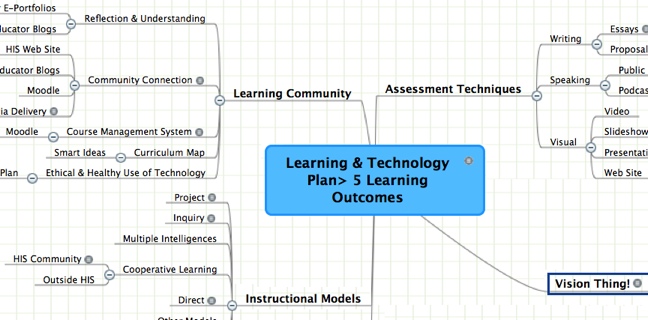
We will be discussing this question in the SOS podcast this week. As an Instructional Technologist, much of my work deals with integrating technology into instruction and assessments. The integration process begins from the big picture (Macro) by looking at the needs of the students and teachers as we design the curriculum and when we create a learning and technology plan focused on student learning. The other approach is when we collaborate, working on individual lessons (Micro) to reach the stated learning objectives.
The Macro: Learning and Technology Plan || The Curriculum Development Process
We recently formed a committee and are currently working on our “Learning and Technology” plan at Hsinchu International School. The process centers upon how we work to have our students reach the five learning outcomes. The Learning Outcomes are:
- Effective Communicators
- Critical Thinkers & Problem Solvers
- Persons of High Character
- Active Learners
- Community Contributors
There are three main ways we work to help our students reach these learning goals:
- Instructional Models
- Assessment Techniques
- Learning Communities
We use MindMeister to map out and collaborate as we develop our plan. The screenshot above is our initial effort to prime the committee work. As one can see, no listing of any technology tools at the primary level exists. It is all about teaching and learning.
Looking closer at the mind map, one category is “Instructional Models.” Two models that we use frequently at HIS are project-based and inquiry-based. Our next step is to define what each of these models looks like in our classrooms and then look for ways that technology and Information & Communication Literacy (ICL) can support and enhance each approach. If we were using a multi-level concept-mapping tool like Smart Ideas, the technology tools would begin to appear on the third level. The technology infrastructure is down at the fourth level, way in the background, providing the foundation for the technology tools that support the learning at the upper two levels.
We will use the Learning and Technology plan to design our professional development goals for the coming school year. The focus will be on improving instructional and assessment techniques while expanding the learning community. We will provide the PD to help educators learn the technology and ICL tools/skills that our plan shows as needed to support the three main categories that support our five student learning outcomes at the center of our plan and school.
The curriculum development process is a part of our plan in the Learning Community category. We use the Understanding by Design process to create our units of study that also involve integrating technology and ICL skills.
The Micro: When working with teachers on one or in small groups, we again use the UbD approach to determine what the learning will look like and how we will assess it to work backward in creating the instruction and content. As the collaboration progresses, we discuss possible ways technology and research skills can support and enhance the learning. As with the broad, school-wide approach of the Learning and Technology plan, the technology only enters the picture once we are far along in designing how to meet the learning objectives.
The learning determines the technology. Not the other way around.
May 14, 2008 at 4:38 am
For curriculum design, one mindmap will do. For experiential learning from tryouts and implementations over the years by many people, it won’t. IMHO you need multiple maps clustering the same objectives from multiple, ‘moving’ viewpoints, to then finally be able to synthesize them into the best design possible.
May 22, 2008 at 5:04 am
David, I love, love, love Mindmeister- easier than inspiration and it’s collaborative! We’re just starting to rewrite curriculum and job descriptions related to tech so it’s great as there’s never enough time to actually meet. We also use moodle and I can see students prewriting/planning and then moving it into their moodle collab site to continue a group or individual project.
I’ve also listened to SOS #11 the first time and want to go through it again. The future is so exciting for educators…
Thank you!! -Nancy